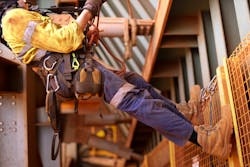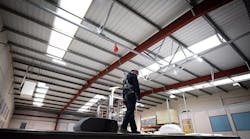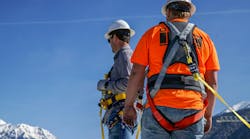The ABCDs of Fall Protection: Why a Rescue Plan is as Crucial as the Arrest
Key Highlights
- Fall protection plans don’t stop at harnesses, anchors and other personal protective equipment. They must also include step-by-step instructions for rescue after a fall.
- Every second counts after a fall. Make sure employees know what to do to protect themselves and their colleagues from injury and suspension trauma.
- The best fall protection strategy is to prevent them from ever happening. That means offering ongoing training sessions and building time into the schedule to conduct those preventive safety measures before every shift begins.
Falls remain one of the leading causes of workplace injuries and fatalities. According to the Bureau of Labor Statistics (BLS), in 2022, falls resulted in the tragic deaths of 865 workers, and in 2023, more than 8.8 million people were treated in emergency rooms for fall-related injuries. While most safety programs focus on preventing falls or stopping them midair, far fewer address what happens next—when a worker is left hanging (quite literally) in limbo.
When a worker is left suspended in a harness, time becomes the enemy. Without a practiced rescue plan, the outcome can quickly shift from a near-miss to a tragedy. That’s why understanding the ABCDs of fall protection is essential for every safety manager, supervisor and employer.
A Simple Framework for a Complex Safety Issue
To help safety professionals build robust fall protection programs, experts rely on a four-part system known as the ABCDs of fall safety:
- A – Anchorage: This refers to secure attachment points to which a worker’s fall protection gear (e.g., lifelines, lanyards or deceleration devices) is connected. The Occupational Safety and Health Administration (OSHA) requires that each anchorage point must support at least 5,000 pounds per worker attached.
- Examples: fixed beams, roof anchors or mobile tripods.
- Best practice: Position anchors above the worker’s head to reduce free-fall distance and minimize swing hazards.
- B – Body Support: The full-body harness is the only acceptable form of body support for fall arrest. Unlike body belts, which concentrate fall forces on the abdomen and can cause severe internal injuries, a full-body harness is designed to distribute those forces across the stronger parts of the body: the shoulders, upper thighs and pelvis.
- Key feature: the dorsal D-ring (center back) keeps workers upright and reduces spinal injury risk.
- Fit tip: Harnesses must be properly sized and adjusted to prevent slippage or circulation issues.
- C – Connectors: These refer to the devices that link the worker’s harness to the anchorage point, such as lanyards, self-retracting lifelines (SRLs), rope grabs and shock absorbers.
- OSHA requirements: Free-fall distance must not exceed 6 feet and arresting force must be limited to 1,800 pounds or less.
- Compatibility is critical: Mismatched connectors can lead to dangerous failures.
- D – Descent and Rescue: This is the post-fall plan: the equipment, training and protocols needed to safely retrieve a suspended worker. Despite its importance, descent and rescue is often the weakest link in fall protection programs. Investing in top-tier harnesses and anchors without a rescue plan leaves workers vulnerable to a deadly, overlooked threat: suspension trauma.
- Worker training: Regular hands-on training allows crews to practice activating rescue equipment and perform self-rescue if it’s ever needed.
Suspension Trauma: Why Every Second Counts
Fall arrest systems are designed to keep the body upright after a fall, which helps protect the spine from impact-related injuries. However, the human body isn’t designed for prolonged vertical suspension without movement. When a worker is suspended in a harness:
- gravity pulls blood into the legs,
- harness straps compress the femoral arteries, and
- reduced blood flow deprives the brain and vital organs of oxygen.
Without timely rescue, this combination can trigger a potentially fatal condition known as suspension trauma. The body’s initial response is to speed up the heart rate to compensate. However, this is a losing battle against the alarmingly rapid progression of symptoms:
- 0-5 minutes: dizziness, nausea, numbness in legs.
- 5-15 minutes: loss of consciousness, potential airway compromise.
- 15+ minutes: kidney, brain, and organ failure; possible death.
Suspension trauma is swift, silent and often underestimated. A rescue plan isn’t optional; it’s lifesaving.
Immediate Fall Response Safety Protocols
After a fall arrest, crews must act quickly. Key steps include:
- Lower limb activation: Train workers to pump their legs while suspended to activate their muscles and promote blood circulation. An invaluable and inexpensive tool for this is a pair of suspension trauma straps. These lightweight straps attach to the harness and can be deployed by the worker to create a loop to stand in, alleviating pressure and allowing them to use their leg muscles.
- Utilize on-site equipment for support: A rescue doesn’t have to be complex. In some cases, giving the suspended worker a portable ladder or anything they can stand on can prevent suspension trauma. If possible, the on-site team can also guide the worker to a nearby structure, such as a beam or platform.
- Continuous communication: Talk to the suspended worker to keep them conscious, calm and responsive while the rescue is in progress.
Training workers on these immediate actions buys precious minutes until full extraction.
From Prevention to Rescue: Developing a Proactive Fall Safety Program
A robust fall safety program accounts for every potential hazard, hindrance and rescue scenario. This enables you to craft a clear and comprehensive plan of action that not only reduces the likelihood of a fall and ensures an effective rescue but also reinforces daily awareness. This process should start before every job and every shift, especially for crews working in the field where conditions can change quickly. And it’s essential that everyone on the team—not just safety professionals—is trained to recognize hazards, use equipment correctly and follow established protocols.
Here are some key strategies to help guide your plan:
1. Conduct a thorough hazard assessment
- Walk the site to identify fall risks and rescue barriers.
- Evaluate elevated work areas, access points and obstructions.
- Ask: “How fast can we reach a suspended worker here?” This assessment shapes the rescue equipment and strategies your site requires.
2. Implement comprehensive fall prevention measures
- Install engineering controls: guardrails, warning lines, toe boards and controlled access zones.
- Ensure all fall protection PPE—harnesses, connectors, anchors—meet OSHA standards.
- Tailor solutions to each task and worksite, combining environmental controls with personal fall arrest systems.
3. Establish a clear rescue plan
- Document site-specific rescue procedures.
- Assign roles and responsibilities for rescue team members.
- Train crews on equipment, such as controlled descent devices, hoists or pulley systems.
- Practice drills regularly to build confidence and speed under pressure.
4. Promote a culture of awareness
- Conduct toolbox talks on suspension trauma and its dangers.
- Empower workers to report hazards and suggest solutions.
- Reinforce the “why” behind rescue training; when workers understand, they engage more fully in their own safety.
The Role of Training and Technology
Rescue planning succeeds only if people are prepared. OSHA requires employers to provide training, but the best programs go further. They offer:
- hands-on drills to simulate real rescue scenarios;
- equipment familiarization so workers should know how to deploy SRLs, trauma straps or controlled descent devices instinctively; and
- technology integration with wearable sensors and connected PPE that can detect a fall and alert supervisors instantly, speeding up response times.
Together, these elements create a workforce that can act confidently and correctly in critical moments. They also help close the gap between “having a rescue plan” and having a rescue plan that works.
For safety leaders looking to deepen their programs, OSHA offers extensive guidance on fall protection systems, training requirements and rescue preparedness. Exploring OSHA’s fall protection standards and training resources can help organizations strengthen their internal protocols and ensure their teams remain ready for any scenario.
From Arrest to Rescue: Completing the Safety Circle
Fall arrest systems are only part of reducing falls along with fall-related injuries and fatalities. Without a rescue plan, workers remain at risk even after surviving the initial fall, especially due to suspension trauma, which can become life-threatening in as little as 15 minutes.
The concept of the safety circle emphasizes that fall protection must cover the entire lifecycle of a fall event: before the fall (prevention), during the fall (arrest) and after the fall (rescue). If any part is missing, the circle is broken. As a result, workers are left vulnerable.
By committing to the full ABCDs of fall safety, employers complete the circle. The reward isn’t just regulatory compliance. It’s lives saved, injuries avoided, and workers who know their employers are committed to sending them home safely at the end of their shifts.
Read more
About the Author

Rick Pedley
Rick Pedley is president and CEO of PK Safety, a supplier of occupational safety and personal protective equipment since 1947.






